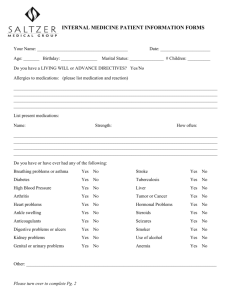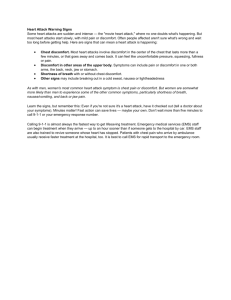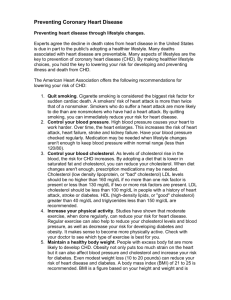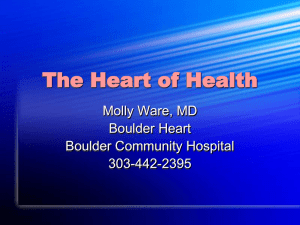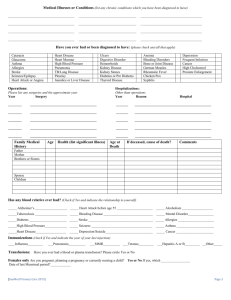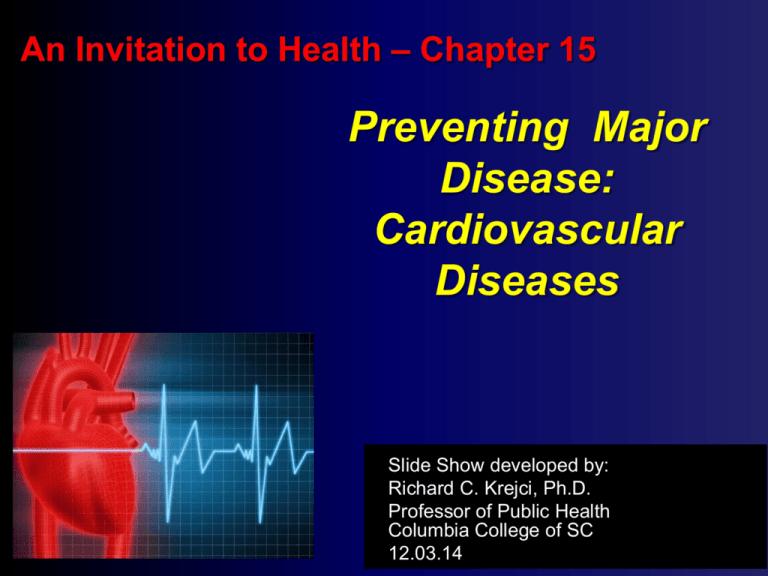
An Invitation to Health – Chapter 15
Preventing Major
Disease:
Cardiovascular
Diseases
Slide Show developed by:
Richard C. Krejci, Ph.D.
Professor of Public Health
Columbia College of SC
12.03.14
Topics Of Focus For This Chapter
Cardiometabolic
Health
Heart Attack
Diabetes
Stroke
Hypertension
Cancer
Cholesterol
Others: Epilepsy,
Asthma, Ulcers
Chapter 15 Objectives
Define cardiometabolic health, and distinguish between
risk factors that can and cannot be controlled
Discuss the types of diabetes
mellitus, and describe the early
symptoms, health consequences,
detection methods and treatments.
Discuss hypertension,
including health consequences,
prevention, and treatments.
Identify the types of cholesterol that compose your lipoprotein
profile, health consequences, recommended levels, and
prevention and treatment for elevated cholesterol.
Chapter 15 Objectives
Explain heart function and define myocardial infarction.
Contrast stroke and transient
ischemic attacks.
Discuss the most common types of
cancer, and describe the treatments
of each.
Evaluate your personal cardiometabolic and cancer risk
factors along with the strategies to decrease your risk.
Cardiometabolic Health
Cardiometabolic
“Cardio” refers to the heart and blood
vessels of the cardiovascular system;
“metabolic,” to the biochemical
processes involved in the body’s
functioning.
Cardiometabolic Risk Factors
•
•
•
•
•
•
•
•
•
Factors You Can Control
Physical Inactivity
Tobacco use
Obesity
High Blood Pressure
Blood Fats (lipids)
Metabolic Syndrome
Diabetes Mellitus
Stress/Psychosocial
Factors
Drug/Alcohol Use
Factors You Can’t Control
• Heredity
• Race and Ethnicity
• Age
• Gender
• Bacterial infections
Cardiometabolic Risk Factors You Can Control
Physical Inactivity
The risk for heart disease is 1.5 to
2.4 times higher for people who
are inactive compared with those
that are regularly active.
Cardiometabolic Risk Factors You Can Control
Tobacco use
The single most significant risk
factor for cardiovascular
disease.
Cardiometabolic Risk Factors You Can Control
Obesity
Losing weight thru exercise and
diet at any age can help reduce
the risk of heart problems.
Cardiometabolic Risk Factors You Can Control
High Blood
Pressure
The higher the blood pressure
reading, the greater the risk of
stroke and heart disease.
Cardiometabolic Risk Factors You Can Control
Blood Fats (lipids)
For every 1% drop in blood
cholesterol, studies show a 2%
decrease in the likelihood of a
heart attack.
Metabolic Syndrome
Syndrome X or Insulin-Resistant Syndrome
Definition:
•
•
A cluster of disorders of the body’s metabolism that
make diabetes, heart disease, or stroke more likely.
Affects 1 in 3 Americans
The Five Diagnostic Criteria:
1. Waist Circumference: Men > 40 inches;
Women >35 inches.
2. Triglycerides: >150 mg/dL.
3. High-Density Lipoprotein: Men <40 mg/dl;
Women <50 mg/dl.
4. Blood Pressure: 130 mm Hg (systole)/85 mm Hg
(diastole).
5. Fasting Blood Sugar: >110 mg/dl.
Cardiometabolic Risk Factors You Can Control
Metabolic
Syndrome
Men with three factors of metabolic
syndrome are nearly twice as likely to
have a heart attack or stroke and
more then three times more likely to
develop heart disease than those with
none.
Cardiometabolic Risk Factors You Can Control
Diabetes Mellitus
Increases the likelihood of
hypertension and
atherosclerosis, thereby
increasing the risk of heart attack
and stroke.
How Diabetes Affects The Body
Pancreas
produces
sufficient
insulin
Glucose absorbed
after a meal
Glucose
levels in
bloodstream
rise
Pancreas
does not
produce
sufficient
insulin
Glucose
Insulin • Body cells take levels
Normal fasting
up glucose
glucose:
• Suppression of
liver glucose in blood 70-100 mg/dL
output
fall
• Suppression of
fat release from
body stores
High
• Body cells
levels of can’t take
up glucose
glucose • Body uses
in blood stored fat
• Damage to blood
vessels
• Risk of kidney
damage, blindness,
amputation, heart
attack, stroke
Diabetes Shortens Life Expectancy
Women
8.4 years
Men
7.8 years
Normal Response To Eating
Uncontrolled Diabetes
Effects Of Uncontrolled Diabetes
Damaged blood vessels
Blindness
Amputation
Kidney failure
Heart attack and stroke
Three Types Of Diabetes
Diabetes Signs and Symptoms
Increased thirst and frequent urination
Flu-like symptoms
Weight loss or weight gain
Blurred vision
Slow-healing sores or frequent infections
Nerve damage (neuropathy)
Red, swollen, tender gums
Detecting Diabetes
Random Blood
Sugar ScreeningTest
Fasting Blood
Glucose Test
Glucose
Challenge Test
ABCs of Diabetes
Management
A is for A1c test
(blood sugar) less than
7 percent
B is for blood pressure
115/75 or lower
C is for cholesterol
LDL less than 160
Diabetes Facts in South Carolina…
Affects over 350,000 people (~6% of SC population)
• Approximately 1 in 8 African-Americans in South Carolina has
diabetes – the 21st highest rate of diabetes among AfricanAmericans in the nation.
• 50% of those with diabetes have not been diagnosed
• Contributes to over 2000 deaths annually
• Increases cardiovascular disease risk by 3-4 times and Is associated
with obesity, hypertension, high cholesterol, and triglycerides
• Causes over 200 new cases of blindness each year
• Hospitalization costs exceed $260 million each year
• Education and lifestyle changes can prevent many of the
complications from diabetes
Source List: 2007 Behavior Risk Factor Surveillance Survey, 2007 American Diabetes Association (ADA),
DHEC SCAN (South Carolina Community Assessment Network), ADA 2009 Clinical Recommendations
Blood Pressure
Definition: A measure of the force exerted against the walls of
the vessels by the blood flowing through them.
Systolic Blood
Pressure
Highest blood pressure
when the heart contracts.
Diastolic Blood
Pressure
Lowest blood pressure
between contractions of
the heart.
Sphygmomanometer &
Stethoscope
Preventing Hypertension
Lifestyle Changes
•
•
•
•
Lose weight
Exercise regularly
Consume adequate amounts of folate
Follow the DASH Diet
•
•
Dietary Approaches to Stop Hypertension
Restrict daily sodium intake
What Does Your Blood Pressure
Mean?
Top Number
(systolic)
Bottom Number
(diastolic)
Below 120
and
Below 80
Normal blood
pressure
Maintain a healthy
lifestyle
120-139
or
80-89
Prehypertension
Adopt a healthy
lifestyle
140-159
or
90-99
Stage 1
hypertension
Adopt a healthy
lifestyle; take
medication
100 or more
Stage 2
hypertension
Adopt a healthy
lifestyle; take more
than one
medication
160 or more or
Numbers are expressed in millimeters of mercury (mm Hg).
Your Group
What to Do
Eye damage
Prolonged high blood pressure can
damage delicate blood vessels on
the retina, the layer of cells at the
back of the eye. If the damage,
known as retinopathy, remains
untreated, it can lead to blindness.
Heart attack
High blood pressure
makes the heart
work harder to pump
sufficient blood
through narrowed
aterioles (small
blood vessels). This
extra effort can
enlarge and weaken
the heart, leading to
heart failure. High
blood pressure also
damages the
coronary arteries
that supply blood to
the heart,
sometimes
leading to blockages
that can cause a
heart attack.
Stroke
High blood pressure can damage vessels that
supply blood to the brain, eventually causing them
to rupture or clog. The interruption in the blood
flow to the brain is known as a stroke.
Damage to artery walls
Artery walls are normally smooth, allowing blood
pressure to flow easily. Over time, high blood
pressure can wear rough spots in artery walls.
Fatty deposits can collect in the rough spots,
clogging arteries and raising the risk of a heart
attack or stroke.
Rough artery walls
Clogged artery
Kidney failure
Prolonged high blood pressure can damage
blood vessels in the kidney, where wastes are
filtered from the bloodstream. In severe
cases, this damage can lead to kidney failure
and even death.
Consequences of High Blood Pressure
Hypertension
Family history
Obesity when young
Risks
Race
Death especially for those with
Effects
diabetes, kidney disease and obesity
Lifestyle changes
Decrease sodium to 1.5 grams/day
Treatment Increase potassium to 4.7 grams/day
Exercise
Medication
Making Heart Healthy Changes
Changes You Can Make Today
•
Eat a good breakfast: whole-grain cereal, juice, yogurt, and
so forth.
•
Skip desert at dinner.
•
Eat one more serving of vegetables.
•
Eat one more piece of fruit.
•
Drink one more glass of water.
•
Take the stairs for one or two flights rather than riding the
elevator to your dorm room or classroom building.
•
Get seven to eight hours of sleep a night.
Making Heart Healthy Changes
Changes You Can Make This Week
•
If you have not had your blood lipoproteins
checked within the last year, schedule a screening
test.
•
Block out time for exercise on your calendar.
•
Make a list of stress-reducing activities.
•
Hobbies
•
Arts/Entertainment
•
Social: get in touch with an old friend.
Making Heart Healthy Changes
Changes You Can Make Right Now!
•
Be patient and look for new ways to meet
your lifestyle goals.
•
If you slip up and smoke again or blow your
diet, don’t give up.
•
Develop and use a support system of
friends and family members.
Making Heart Healthy Changes
Becoming More Active
Benefits
Reduction in body weight
Reduction in blood pressure
Reduction of harmful LDL cholesterol
Increase in beneficial HDL cholesterol
Increase in insulin sensitivity
American Heart Association, American College of Sports
Medicine and the Center for Disease Control
30 to 60 minutes or more of moderate-intensity physical activity on
most, if not all, days of the week to reduce heart disease risk by 30-40%
Making Heart Healthy Changes
Choosing Heart-Healthy Foods
•
•
Dietary Recommendations
•
Plenty of fruits and vegetables.
•
Cholesterol lowering foods such as oats, barley, soy
protein, and nuts.
•
Fish 2 times a week (AHA).
Insufficient evidence exists to recommend for or
against the use of:
•
Supplements of vitamin A, C, or E.
•
Multivitamins with folic acid.
•
Antioxidant combination supplements.
Superior
vena cava
Aorta
Right pulmonary
artery
Left pulmonary
artery
Right pulmonary
veins
Left pulmonary
veins
Right atrium
Left atrium
Right coronary
artery
Left coronary
artery
Right ventricle
Left ventricle
Inferior
vena cava
Pericardium
The Healthy Heart
Capillary beds of
lungs, where gas
exchange occurs
The Path of
Blood Flow
Pulmonary
arteries
Venae
cavae
Pulmonary
veins
Aorta and
branches
Left
atrium
Left
ventricle
Right
Right
atrium
ventricle
Oxygen-poor
CO2-rich blood
Oxygen-rich
CO2-poor blood
Capillary beds of all body tissues,
where gas exchange occurs
Tobacco and Heart Disease
•
Smoking is the single most significant risk factor
for CV disease and peripheral vascular disease.
•
Each year smoking causes 250,000+ deaths
from cardiovascular disease.
•
Active vs. passive exposure to tobacco smoke.
How Smoking Damages The
Heart
•
Nicotine over-stimulates the heart.
•
Carbon monoxide reduce the oxygen supply to the heart.
•
Tar and other smoke residues increase the risk of
cholesterol build-up in the arteries.
•
Smoking increases blood clotting.
•
Smoking causes constriction and irreversible damage to
the coronary arteries.
Your Lipoprotein Profile
Low Density
Lipoprotein
(LDL)
High Density
Lipoprotein
(HDL)
Very Low Density
Lipoprotein
(VLDL)
Triglycerides
Fatty substances produced by the liver that carry
cholesterol to arterial walls; “bad” cholesterol.
Fatty substance that picks up cholesterol in the
blood-stream and returns it to the liver; “good”
cholesterol.
The largest of the lipoproteins which allow
cholesterol to circulate in the bloodstream.
Fats that flow through the blood after meals and
have been linked to increased risk of coronary
artery disease.
What Is A Healthy Cholesterol Reading?
Blood Lipid
Level
Rating
Total Cholesterol
< 180 mg/dl
181-239 g/dl
> 240 mg/dl
Desirable
Borderline High
High Risk
LDL Cholesterol
<100 mg/dl
100-129 mg/dl
130-159 mg/dl
160-189 mg/dl
190+ mg/dl
Optimal
Near Optimal
Borderline High
High
Very High
HDL Cholesterol
> 45 mg/dl
36-44 mg/dl
< 35 mg/dl
Desirable
Borderline High
High Risk
Two Approaches to Lowering
Cholesterol
•
•
•
Therapeutic Life
Changes (TLC)
Dietary changes
Weight management
Physical activity
Medications
•
•
•
•
Statins Interactions with Grape Fruit
Nicotinic acid (niacin)
Fibrates
Aspirin
Other Risk Indicators
•
•
•
C-Reactive Protein (CRP)
•
Produced in the liver and rises whenever the body responds to
inflammation
•
High- sensitivity CRP test (hsCRP) can predict heart disease before any
other risk factors become evident, particularly in women
Lowering CRP Levels:
•
Lifestyle changes (healthy diet, exercise, weight control, and not smoking)
•
Medications (aspirin, and as needed, drugs to lower cholesterol and blood
pressure)
Homocysteine
•
•
An amino acid found in the blood which is linked to a greater risk of heart
disease and stroke.
Lowering Homocysteine Levels:
•
Adequate intake of folic acid and vitamins B6 and B12.
C-Reactive Protein (CRP) Levels and
Cardiovascular Disease Risk
CRP
(milligrams per liter)
Less than 0.5 mg/L
Less than 1 mg/L
1-3 mg/L
Greater than 3 mg/L
Level of
Cardiovascular Risk
Lowest
Low
Moderate
High (risk doubles)
Crises of the Heart
Coronary Artery
Disease
(atherosclerosis) (click)
Angina Pectoris
(chest pain or pressure)
Coronary Artery
Spasms (symptoms
mimic a heart attack)
Heart Attack
(Myocardial Infarction)
Heart Health Conditions
Coronary Artery Disease
Arteriosclerosis – degeneration and hardening of
arterial walls
Atherosclerosis – arteriosclerosis plus plaque
deposits on walls of arteries
Can One Reverse
Atherosclerosis?
Low Fat,
Vegetarian Diet
Yoga,
Meditation,
Imagery
Moderate
Exercise
Stress Counseling
Symptoms of a Heart Attack?
•
A tight ache, heavy, squeezing pain in the
center of the chest
•
Chest pain that radiates to the shoulder, arm,
neck, back or jaw
•
Anxiety
•
Sweating or cold, clammy skin
•
Nausea and vomiting
•
Shortness of breath
•
Dizziness, fainting, or loss of consciousness
Symptoms in Women
Heart Attack (Myocardial Infarction)
Blood flow
Aorta
Plaque
breaks
loose
Blood
clot
Left coronary
artery
Blockage
Right
coronary
artery
Area of
myocardial
cell death
Blood flow
Artery spasm
can block
blood flow
Treatments That Save Lives
•
Clot-dissolving drugs
•
•
Clot-thinning drugs
•
•
•
•
•
•
Thrombolytic agents
Thrombolytic
Platelet receptor blocker
Early administration of
appropriate medications to
dissolve clots.
Intravenous nitroglycerin
Beta-blockers
Angioplasty
Saving Hearts During Cardiac Arrest
Cardiopulmonary
Resuscitation
(CPR)
•
A method of artificial stimulation
of the heart and lungs; a
combination of mouth-to-mouth
breathing and chest
compressions.
•
When the heart stops beating,
circulation must be restored in
four or five minutes or the brain
shuts down completely, and the
person dies.
Saving Hearts During Cardiac Arrest
Defibrillation
•
A device used to actually
restart the heart with a lethal
rhythm (AED).
•
A combination of CPR and
defibrillation boosts the
survival rate much higher
than from CPR alone.
Heart Savers
Diagnostic Tests
•
•
•
Electrocardiogram (ECG, EKG)
Thallium scintigraphy
Coronary angiography
Treatments
•
•
•
Aspirin therapy
Medications
• Diuretics, beta-blockers, calcium channel blockers,
angiotensin-converting enzyme inhibitors (ACE).
Surgical Procedures and Mechanical Aids
• Coronary bypass, percutaneous transluminal
coronary angioplasty, heart transplant, and leftventricular-assist devices (LVADs).
Stroke
Definition
• When the blood supply to a portion of the brain is
blocked. Also called a cerebrovascular incident.
Statistics
• Strokes are the 3rd leading cause of death in the U.S.
• Worldwide, strokes are the second leading cause of
death.
Types
• Ischemic stroke: The result of a blockage that disrupts
blood flow to the brain.
• Hemorrhagic stroke: Occurs when blood vessels
rupture.
Causes
• Cerebral thrombosis, cerebral embolism, head injury and
bursting of an aneurysm.
How to Recognize a Stroke
Ask the individual to smile.
Ask him or her to raise both
arms.
Ask the person to speak a
simple sentence, such as “It is
sunny out today.”
Ask the person to stick out
their tongue
If he or she has any trouble
with any of these tasks, call
9-1-1 immediately and
describe the symptoms to the
dispatcher.
Risk Factors for Strokes
Gender
Race
Age
Hypertension
High Red Blood Cell Count
Heart Disease
Blood Fats
Diabetes Mellitus
Estrogen Therapy
A Diet High in Fat and Sodium
Prevention and Treatment for Strokes
•
Low-dose Aspirin Therapy
•
•
Surgery
•
•
•
A baby aspirin a day may keep a stroke
away.
Carotid endartectomy
Brain angioplasty
Medications
•
Thrombolytic drugs
•
•
•
Tissue-type plasminogen activator (tPa)
Heparinoids
Nimodipine
Effects Of Stroke On Brain
Protecting Your Heart
•
•
•
•
•
•
•
•
•
•
Don’t smoke.
Watch your weight.
Cut down on saturated fats and cholesterol.
Get moving.
Lower your stress levels.
Know your family history.
Get your blood pressure checked regularly.
Tame your temper.
Get a lipoprotein profile.
Take appropriate medications.
The End
Slide Show developed by:
Richard C. Krejci, Ph.D.
Professor of Public Health
Columbia College of SC
All Rights Reserved


